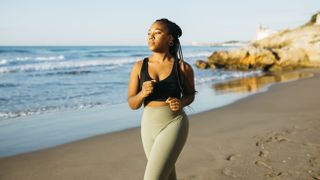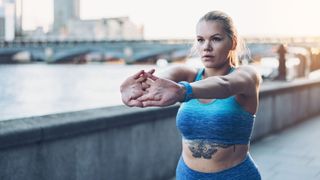How to avoid breast pain while running
The question of how to avoid breast pain while running is a common one. While many of us love the physical and mental health benefits that come with running, the breast pain that comes with it is something we can all live without.
Breast pain (also called mastalgia) while running isn’t all that surprising when you consider how much — and in how much direction — they move during exercise. “Breast pain while running is linked to breast displacement, so it’s not just an up-and-down movement, but also side-to-side and back-to-back motion,” says Michelle Norris, senior research fellow in the department of exercise and exercise science at the University of Portsmouth in the UK.
In fact, the University’s Research Group in Breast Health found that the breasts can move an average of 10cm in three different directions during a run. That’s where the best sports bras for running are (opens in a new tab) can help, especially as a study conducted by the University of Portsmouth (opens in a new tab) also revealed that if the breasts are not properly supported while running, they experience the same G-force as F1 drivers and can experience a potentially damaging stretch of the skin.
As you might expect, women with larger breasts tend to experience more displacement and suffer more discomfort, so it’s worth checking out the best sports bras for big breast offerings. (opens in a new tab) to make sure you get the extra support you need while running. But women with smaller breasts can still experience stretching and damage to the Cooper’s Ligaments – the ligaments that hold the breasts to the chest wall.
So what’s the secret to avoiding breast pain while running and getting rid of chest discomfort for good? We spoke to ultra runner and running coach Alex Parren to find out.
What causes breast pain when running?
“The main reason breasts hurt when running is the strain on the skin and ligaments caused by movement: research (as published in this journal). BMJ (opens in a new tab)) conclusively found that they move in complex patterns that include up and down, side to side, and forward and backward movements, which is what causes the pain,” says Parren.
A BJSM (opens in a new tab) a study of female marathon runners found that 32 percent experienced breast pain and this was significantly related to cup size and was greater during strenuous exercise when compared to moderate exercise.
Can breasts be permanently damaged by running?
Alex says: “The breasts are naturally supported by ligaments called Cooper’s Ligaments — named after the surgeon who first described them. There are no muscles in the breast that hold them together – they are attached to the pectoral (chest) muscles by these ligaments. That is, if it is stretched or damaged, the breast may sag. Running puts a lot of stress on these ligaments and can damage them permanently.”
What is the best way to avoid breast pain while running?
“The best way to avoid breast pain while running is to invest in a very supportive sports bra. Even if you have smaller breasts, your Cooper’s Ligaments still need support and a well-fitting sports bra is the only way to achieve this.”
BraStop (opens in a new tab)‘s bra fitter Katie Weir says: “A sports bra in a bra size is the best way to ensure maximum support when you get the right size and strong band to hold and support you from the bottom (where 80 percent of the support of normal bras and sports bras should be coming from) and the cup will encapsulate your breast tissue to avoid falling out and being squashed!
“The sports bra’s wide back tire and padding/hook and eye straps will ensure maximum comfort in areas of friction when you exercise. I think the best way to avoid breast pain while running is to wear a professionally fitted sports bra — no bust is too small for a bra size! Even the B cups have breast tissue that will move while running and create blisters if not supported properly.”
How do you know if your sports bra fits right?
Before you tie your running shoes, put on one of the best running watches (opens in a new tab) and start hitting the pavement, you’ll want to make sure your sports bra fits properly and gives your breasts the support they need to prevent discomfort.
“There are several tests you can do to make sure your sports bra fits properly. You have to be able to fit two fingers between your shoulder and the strap to make sure it’s not too tight to impede breathing,” says Parren.
“There shouldn’t be any wrinkles in the fabric — it should fit snugly and be smooth against your skin. Lastly, make sure the band around your ribs fits snugly as this will provide a lot of support. The first time you try on a new sports bra, do a quick test by bouncing or jumping in place to see if your breasts hurt before you even take them out for a run.”
“Once the ligaments and supporting tissues in the breast are damaged or stretched, they cannot return to their original state – they are permanently damaged. This means that you should wear a well-fitting sports bra every time you work out, especially if you have bigger breasts.”
#avoid #breast #pain #running



Comments
Post a Comment